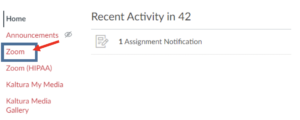Zoom Tutorials:
Using Zoom in a Pooled Classroom with Your Personal Device
Step 1: Launch Zoom on the Room PC
- Launch your web browser of choice, browse to https://mycanvas.wustl.edu, and login.
- Click on the Zoom link in the left navigation:

- Launch a Zoom meeting, either by selecting the appropriate meeting from your “Upcoming Meetings” tab, or by clicking on “Personal Meeting Room”, scrolling down, and clicking “Start this Meeting”:

- When the Zoom window pops up, click
 .
. - Once Zoom launches, click
 .
.
NOTE: For the next several steps, please note that the bottom toolbar in Zoom auto-hides when not in use. If you need to click on an icon, and you don’t see the icons, simply move your mouse to the bottom of the Zoom screen, and the icons will appear.
-
Once you are in Zoom, you can confirm that the microphone audio is working by speaking and watching the
 Microphone icon. As you talk, you should see a green bar go up and down.
Microphone icon. As you talk, you should see a green bar go up and down. -
If the video is not already showing (depending on the Zoom meeting’s settings), you will need to click on
 . If the video is still not showing, click the up arrow next to Start Video, and ensure that AW-HE38 is selected. If not, click on it, and the video should show up.
. If the video is still not showing, click the up arrow next to Start Video, and ensure that AW-HE38 is selected. If not, click on it, and the video should show up. -
You are now connected to Zoom on the Room PC, using the microphone and camera in the room.
-
If you are recording your Zoom session, you can press Record, then Record to Cloud at this time to begin the recording.

Step 2: On the touch panel, press Room PC
There are several ways to teach and record using Zoom with your own device in the classroom, but some options result in echoes and feedback loops. Based on our testing, we have found a method that should work well in most scenarios, and this involves selecting the Room PC as the source. This may seem counter-intuitive when you are presenting with your own device, but you will still be able to share your device’s screen with the room through screen sharing in Zoom. Note also that by using this method, it is not necessary to connect your device to the HDMI or VGA connectors at the desk. If you do still want to use the Laptop HDMI or Laptop VGA source, you can, but note that you may encounter echoes or feedback loops.
Step 3: Launch Zoom on your personal device
- NOTE that you ARE able to launch Zoom using your WUSTL account from the Room PC AND login to the same Zoom session using your WUSTL account from your personal device. You do not need a separate account.
- Follow steps 1 through 4 from above to login to Canvas and launch Zoom on your personal device.
- Click the
 icon at the bottom left of the Zoom window to mute your device’s microphone. The icon will change to show that it is muted ->
icon at the bottom left of the Zoom window to mute your device’s microphone. The icon will change to show that it is muted ->  .
. - At this time, you can launch PowerPoint or any other application that you want to capture on your device to share with the class, then go back in to Zoom.
- Click on
 , then select either your full screen (usually labeled Screen 1) or the specific application that you want to capture.
, then select either your full screen (usually labeled Screen 1) or the specific application that you want to capture.
- NOTE: Be sure to select the checkboxes at the bottom for
 and/or
and/or  as appropriate if you are playing any audio or video in your presentation. This will ensure that remote viewers will be able to hear audio and watch videos smoothly through Zoom.
as appropriate if you are playing any audio or video in your presentation. This will ensure that remote viewers will be able to hear audio and watch videos smoothly through Zoom.
- NOTE: Be sure to select the checkboxes at the bottom for
Troubleshooting
- No display on projector screen:
- Did you select a source on the touch panel?
- Is “Picture Mute” button on the touch panel selected? If so, touch the button to turn it off.
- Getting an echo or audio feedback loop:
- Ensure that on your personal device, you see either “Join Audio”, or “Muted” for microphone at the left of Zoom’s bottom toolbar.
- If Zoom is already “Muted” on your personal device, go into your device’s speaker volume control in the taskbar (on the top right in MacOS and on the bottom right in Windows) and mute the device’s speakers.
- If you see “Muted” in Zoom on your personal device, and the speakers are muted, try changing the Speaker audio device in Zoom to “Same as System”. To do this, click the up arrow next to the Microphone icon and select “Same as System” under the Select a Speaker heading.
- Remote users can’t hear computer audio in Zoom
- Stop the screen share and start it again, being sure to select “Share sound” at the bottom of the pop-up window.